Balbharti Maharashtra State Board Class 11 Geography Solutions Chapter 3 Agents of Erosion Textbook Exercise Questions and Answers.
Maharashtra State Board Class 11 Geography Solutions Chapter 3 Agents of Erosion
1. Compete the Chain.
Question 1.
| Agent | Erosional/Depositional features | Places / Regions |
| (1) River | (1) Caves | (1) China |
| (2) Wind | (2) Beach | (2) Jog |
| (3) Sea waves | (3) Waterfalls | (3) Meghalaya |
| (4) Glaciers | (4) Loess | (4) Diveagar |
| (5) Ground water | (5) Matterhorn | (5) Swiss Alps |
Answer:
| Agent | Erosional/Depositional features | Places / Regions |
| (1) River | (1) Waterfalls | (1) Jog |
| (2) Wind | (2) Loess | (2) China |
| (3) Sea waves | (3) Beach | (3) Diveagar |
| (4) Glaciers | (4) Matterhorn | (4) Swiss Alps |
| (5) Ground water | (5) Caves | (5) Meghalaya |
2. Choose the correct option by identifying the correct correlation in the sentences.
Question 1.
Water or snow enters the cracks in the rocks and makes it weak. When the glacier passes on these rocks, it pulls the rocks at the bottom along with it. This process is called
(a) Plucking
(b) Abrasion
(c) Attrition
(d) Transportation
Answer:
(d) Transportation
![]()
Question 2.
Sometimes, the river starts erosion upstream. This happens when the head stream gets a lot of water in the early stages of river’s flow.
(a) Downcutting
(b) Headward erosion
(c) Lateral erosion
(d) Vertical erosion
Answer:
(b) Headward erosion
Question 3.
Soft rock erodes beneath the hard rock due to sea waves. This results into landforms which further develop as sea arches. The landform is
(a) Sea cave
(b) Sea stack
(c) Sea cliff
(d) Wave cut platform
Answer:
(a) Sea cave
Question 4.
This landform develops due to depositional work of wind. The windward slope of this landform is gentle.
(a) Loess plains
(b) Barchans
(c) Seif
(d) Sand hills
Answer:
(b) Barchans
Question 5.
River, glacier, wind, sea waves and groundwater are the agents of erosion. Following work in the correct order is responsible to form various landforms.
(a) Disintegration, picking up, transportation, weathering
(b) Picking up, disintegration, deposition, weathering
(c) Deposition, transportation, picking up, disintegration
(d) Disintegration, picking up, transportation, deposition
Answer:
(d) Disintegration, picking up, transportation, deposition
3. Give geographical reasons.
Question 1.
The Eastern coast of India have deltas formed by the rivers but the Western coast has estuaries.
Answer:
The Eastern coast of India have deltas formed by the rivers but the Western coast has estuaries because-
- Deltas can form at the mouth of those rivers where the sediment supply is high. On the other hand, where the rivers do not have load of sediments, estuaries are formed. Deltas can also be formed where the sea is not very deep.
- The eastern coast borders the Bay of Bengal.
- Because of the gentle slope on the eastern coast, rivers flow with low velocities and deposit the sediments brought with them at the coast. As a result, deltas are formed at the mouth.
- The western coast borders with the Arabian Sea, which is by and large a rocky coast.
- Its width is also less.
- Moreover, rivers are short and swift. Hence, they flow with high velocities and thus, does not deposit the sediments brought by them at the mouth. They form estuaries.
![]()
Question 2.
There is direct relationship between the velocity of the agents and process of deposition.
Answer:
There is direct relationship between the velocity of the agents and the process of deposition because-
- The velocity at which the agent is moving has a great impact on deposition.
- If the stream or wind slows down, the carrying capacity and the particle sizes carried and deposited will decrease.
- If a stream flows faster, say during flo’ods or when the river is in the mountains, then the carrying power of the stream and the sizes of particles deposited will increase.
- On the other hand, if there is a change in the slope of land or in the direction of flow, deposition may occur there.
- If the slope of a region is almost absent like in plain region, the rivers are unable to carry the sediments further and start depositing.
Question 3.
Compared to all the agents, sea waves work ceaselessly.
Answer:
Compared to all the agents, sea waves work ceaselessly because-
- The movement of sea water carried out by waves is mainly responsible for marine erosion and deposition.
- The sea waves are dashing on the coastline ceaselessly. The erosion in some parts and deposition in the adjoining parts takes place simultaneously.
- The beaches and sand bars are formed due to deposition but they are also eroded.
- The erosive power of waves depends partly on velocity of winds, as waves derive their energy from them and partly on the distance of open ocean over which they are blown.
- Coastal erosion may be caused by hydraulic action, abrasion, impact and corrosion, which work continuously.
- Abrasion is the most effective form erosion by waves. The softer rock along the coastline gets eroded first.
Question 4.
One finds many sheep rocks, horns, Aretes and hanging valleys in the Himalayas.
Answer:
One finds many sheep rocks, horns, Aretes and hanging valleys in the Himalayas because-
1. In Himalayas work of glacier is more predominant due to snow covered peaks and slopes. Sheep rock, horns, Aretes and hanging valleys are formed by glacier. Like other agents of erosion, glaciers too carry out erosion, transportation and deposition.
2. In the Himalayas, glaciers remove rock particles from the surface on which they flow by abrasion which leads to formation of sheep rocks.
3. Ice movement, accompanied by weathering and mass wasting has steepened the walls at the head of the glacier. This has deepened into armchair-shaped depression called cirque.
4. In Himalayas, two of more cirques have developed and the area between them is narrowed and formed arete and further the headward erosion of the glaciers has eroded the summit leading to the formation of typical peak called horn.
5. The Himalayan glaciers too have tributaries like rivers. The rate of erosion is different. The main valley gets eroded faster and becomes deeper than the tributary glacial valley. These appear to be hanging when seen from the main valley. Thus, hanging valleys are formed.
![]()
Question 5.
Karst landforms are seen concealed under the surface of the earth.
Answer:
Karst landforms are seen concealed under the surface of the earth because-
- Warmer humid climate has greater amount of vegetation, which supplies CO2 to sub-surface water.
- CO2 is necessary for the acidity of water which makes dissolving easier.
- Water saturated with dissolved CO2 should have easy movement.
- The greater the permeability of the rock, the faster ground water will flow.
- The fractures and joints in the rocks allow passage of water.
- In the areas of water-soluble rocks, such as limestone and gypsum the acidic water dissolves the rock and various landform develop underground.
- Thus, landforms developed by underground water anywhere in the world are called karst landforms.
Question 6.
Snowline decides the limit of glacier work as an agent of erosion.
Answer:
Snowline decides the limit of glacier work as an agent of erosion because-
- Snowline is the lower limit of permanent snow cover; below which snow does not accumulate.
- The glacier moves through pre-existing valley and forms erosive action.
- The glacier performs plucking and abrasion processes on the rocks on its way.
- Below the snowline is the snow frees surface, where the erosional features are not formed.
4. Write short notes on.
Question 1.
Attrition
Answer:
- Attrition is when rocks and pebbles bump into each other and break up into smaller fragments.
- During transit, materials reduce in size.
- Rock particles become more rounded.
- It relates to the material that moves.
- This process of erosion is observed in river, wind and sea waves.
Question 2.
The work of rivers in hilly areas and human activities :
Answer:
Gorges: River from its source, when it starts flowing the process of erosion starts. In mountainous areas, rivers flow at a higher speed due to steep slope. As a result, bed gets eroded more than banks and gorges are formed with steep banks and narrow beds. Such gorges have also become famous tourist places. For example, Gorge of Narmada river at Jabalpur.
In ‘V’ shaped valleys of river, terraced farming is practiced on valley slopes.
In hilly areas, the river has speed, slope and hence downcutting is on a lower scale. Thus, agriculture, agroforestry, animal husbandry and forestry are the major human occupations in these regions.
Waterfalls: Water flowing over a hilly region comes down a cliff, forming alternate bands of eroded soft and hard rocks, such features are called waterfalls. These waterfalls become a site for tourist attraction. For example, Jog falls on Sharavati river, Chuliya falls on Chambal river and Venna falls in Mahabaleshwar. Hotel industries also developed along these features.
![]()
Question 3.
Conditions necessary for work of wind
Answer:
Wind is a significant agent of erosion in the deserts. Following conditions are necessary for wind to become effective:
- Arid areas are essential. In such areas, the rate of evaporation is greater than rate of precipitation. Due to dryness the soil becomes loose and is carried by the wind.
- Sparse vegetation cover or absence of trees, so that there is no obstacle for wind.
- Presence of dry loose materials at the surface which carries out erosion.
- A wind velocity high enough to pick up and move sediments.
5. Differentiate between.
Question 1.
Attrition and Abrasion.
Answer:
| Attrition | Abrasion |
| (i) Attrition is the process of erosion in which rocks and pebbles bump into each other. | (i) Abrasion is the process of erosion which involves scratching and polishing of the surface of bedrock. |
| (ii) In attrition, the rocks and pebbles break up into smaller fragments. | (ii) In abrasion, the rock particles rub against and wear away the surface. |
| (iii) The eroded bedrock on surface have a smooth side. | (iii) The pebbles or rocks become smooth and rounded. |
| (iv) Attrition relates to the material that moves. | (iv) Abrasion affects the surface along which the material moves. |
Question 2.
U shaped valley and V shaped valley.
Answer:
| U shaped valley | V shaped valley |
| (i) It is an erosional feature formed by glaciers as an agent of erosion. | (i) It is an erosional feature formed by river as an agent of erosion. |
| (ii) The glacier moves through pre-existing valley to form U-shaped valleys. | (ii) The river carves out its own valleys. |
| (iii) Due to lateral erosion the valley becomes broad at the bottom. | (iii) Due to vertical downcutting, the valley deepens. |
![]()
Question 3.
Stalactite and Stalagmite.
Answer:
| Stalactite | Stalagmite |
| (i) Water saturated with calcium carbonate drips onto the floor from the ceiling. This dripping water dries and builds massive structures. These structures growing from the ceiling are called stalactites. | (i) Water saturated with calcium carbonate drips onto the floor from the ceiling. This dripping water deposited on the floor dries forming structures are called stalagmite. |
Question 4.
Tributaries and Distributaries.
Answer:
| Tributaries | Distributaries |
| (i) When a number of small rivers join the main river, those are called tributaries. | (i) When the main river breaks up into smaller streams, those the called distributaries. |
| (ii) It may originate from glaciers, lakes or springs. | (ii) It is formed from the main river. |
| (iii) Generally, it does not change its course. | (iii) It diverts from the main river in the delta region. |
| (iv) Tributaries add water to the main river. | (iv) Distributaries (take away) divert water from the main river. |
| (v) River Yamuna is a tributary of river Ganga. | (v) River Hooghly is the distributary of River Ganga. |
6. Answer in detail.
Question 1.
Explain the landforms formed by different agents through the process of abrasion.
Answer:
Abrasion involves the scratching and polishing of the surface or bedrock by the particles which are moving onto it. Let us study different landforms formed by different agents of erosion through the process of abrasion.
Work of Seas Waves:
- Sea cliffs : Sea cliffs are carved where waves strike directly against rocks. The softer rock along the coastline gets eroded first.
- Caves : Sometimes, waves can erode the softer part and make it hollow enough to be called a cave.
- A sea arch : A sea arch forms when waves erode a layer of soft rock underneath a layer of hard rock.
- Sea stack : If a sea arch collapses, it creates a sea stack, which looks like a large rock in the middle of water.
- Headland : The part of land projecting into the sea is called headland.
- Wave-cut platforms : Surfaces at the base of the cliffs are called wave-cut platforms. Extensive platforms are developed where the rocks are least resistant to wave erosion. They are visible at lower water levels, such as at low tide.
Work of Wind:
(i) Ventifacts:
Abrasion carves the windward side of rock into smooth sloping surface. These rocks are called ventifacts.
(ii) Mushroom rocks
- The high rising rocks in the path of the wind are attacked by the sand that moves with the wind.
- Winds and the particles they carry attack the base of an individual rock.
- The larger top part is not eroded as much as the basal part because the particles are not lifted at a height.
- The particles at medium height are smaller but their velocities are high. Hence, their impact is more.
- As a result, the portion of rock at medium height is eroded more and the rock as a whole gets the shape of a mushroom.
(iii) Yardang:
- In areas where hard and soft rocks are found, the softer rocks get more eroded faster.
- The eroded portion of softer rocks appear like elongated ridges and harder rocks appear as elevated portions.
- A yardang is the remaining part of a ridge where rocks have been eroded.
Work of Glaciers
(i) Roche moutonnee:
They are bedrock hills that are smoothly rounded on the upper side by abrasion and plucking on the lower side.
(ii) Cirque
- An armchair like feature is formed when ice movement accompanied by weathering and mass wasting steepens the wall at the head of the glacier.
- It deepens into armchair-shaped depression called cirque.
(iii) Arete
- Often two or more cirques develop side by side.
- This leaves the area between any two of them into a narrow wall. This is called arete.
(iv) Horn
- When three or more cirques are formed, the headward erosion of the glacier erodes the summit.
- This leads to formation of a characteristic peak which is called a horn. The Matterhorn in the Swiss Alps is an example.
(v) U-Shaped Valleys
When glaciers move ahead, they erode the sides as well as the bottom of the valleys they flow through. This makes the valley broad at the bottom, forming a ‘U’. This is called a U-shaped valley.
![]()
Question 2.
Explain how the depositional work done by River Ganga has been beneficial to human activities.
Answer:
The River Ganga and its tributaries have deposited load of sediments in the northern Ganga region. Features formed are:
Alluvial Plain Region : The River Ganga and its tributaries bring loads of sediments – organic sediments like dead remains of plants and animals, skin, hide, bones etc., and inorganic sediments like sand, silt, clay, gravel, etc., and deposits at the foothills of the Himalayan family, Northern Ganga Plain region. It is a fertile land and agriculture is the major human occupation. Along with agriculture river transportation and fishing is also done on a large scale. Fertile plains are in Uttar Pradesh, Bihar, Punjab and Haryana.
Delta: Ganga-Brahmaputra delta, world’s largest delta has been formed at the mouth of the River Ganga. This delta is known as Sundarbans and is located in West Bengal. It is one of the most fertile regions in the world. Most delta is composed of alluvial soil. Thus, agriculture is the occupation followed in this region too.
Question 3.
Which agents of erosion can you see on the cover page of the textbook? Which landforms can you see there? Write the process of formation of any one.
Answer:
- On the cover page of the textbook. We observe the agents of erosion such as rivers, glaciers and sea waves.
- We see different landforms like – alluvial fans, meander, oxbow lakes, delta, sea and beach.
- The river in the middle stage, picks up more material by bank erosion and gets overloaded. The speed of erosion is reduced. The water moves sluggishly in a bed and turns at every minor change of slope and serpentine bends are formed.
Every bend is made more and more pronounced by dashing of water on outer bank which gets eroded while inner banks have deposition. In due course of time they develop into circular loops, they are called meanders.
7. Draw neat and labelled diagrams for
Question 1.
Deflation
Answer:
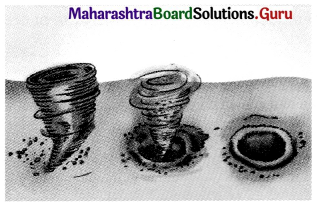
Question 2.
Wave-cut platform
Answer:
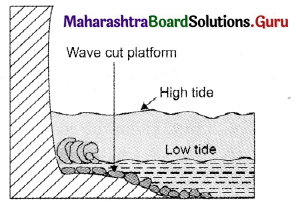
![]()
Question 3.
Mushroom rocks
Answer:
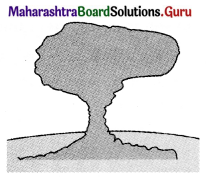
11th Geography Digest Chapter 3 Agents of Erosion Intext Questions and Answers
Can you tell? (Textbook Page No. 27)
1. The names of many places may have some relation with the landforms located there. The names of few of them are given below as example. You are expected to find out the particular landforms to which they are associated. Find about them and try to locate them on a map using an atlas. Make a list of similar examples from India.
| Name of the place | Landform associated with the name | Location |
| Revdanda | Sand bar | Raigad, Maharashtra |
| Ganpati Pule | Beach | Ratnagiri, Maharashtra |
| Pravara Sangam | Confluence of rivers | Ahmednagar Maharashtra |
Answer:
| Name of the place | Landform associated with the name | Location |
| Sundarbans | Delta | West Bengal |
| Triveni Sangam | Confluence of Ganga, Yamuna and Saraswati | Allahabad, Uttar Pradesh |
| Chilika lake | Lagoon | Orrisa |
| Calangute | Beach | Goa |
2. Look at the figure below and answer the questions. (Textbook Page No. 32)
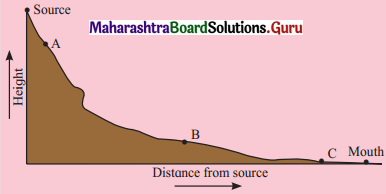
Question 1.
What features are formed in the upper course of the river? What processes will play an important role?
Answer:
Features formed in the upper course of the river are V-shaped valleys, gorges and canyons, potholes, waterfalls and rapids.
Processes responsible for the formation of these landforms are – downcutting, drilling.
Question 2.
Can you mark the location where waterfall may form?
Answer:
Waterfall may form at location ‘A’
![]()
Question 3.
Why is there a change in slope from A to B? How will it influence the flow of the river?
Answer:
There will be a change in slope from A to B when river enters the plains at the foothills of a mountain. The flow of the river decreases, the velocity reduces abruptly.
Question 4.
Which human activities can be conducted in the region around A and B?
Answer:
Around region A terraced farming can be practised. Around region B there is rich with alluvium brough down by the rivers, the plain is extensive and useful for agriculture. As the river widens around the source B, fishing and transportation is also found.
Question 5.
In which area will the process of deposition overtake erosion?
Answer:
Deposition will be found at B and C.
Question 6.
Alluvial fans and deltas are both features formed due to deposition but at different locations. Identify their regions of formation and reason behind their different locations.
Answer:
Alluvial fans will be formed at source ‘B’ at the foothills of the mountains, as there is change in slope and the velocity of the river reduces abruptly. Now the river is unable to carry heavy load. A delta will be formed at the mouth of the river. In this region, which is an extensively flat region, and where the sediments supply is high but velocity is low. So, the river deposits the sediments and branches out to meet ocean or sea.
3. Look at the figure and identify landforms at A, B, C, D, E, F, G. (Textbook Page No. 34)
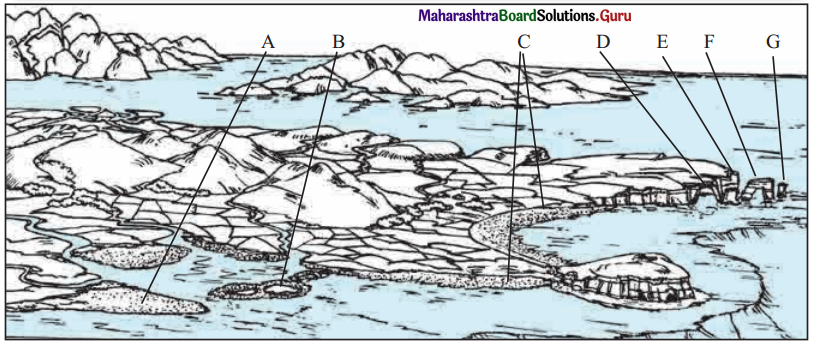
Answer:
A – Headland
B – Lagoon
C – Beach
D – Sea Cave
E – Sea Cliff
F – Sea Arch
G – Sea Stack
Let’s recall. (Textbook Page No. 30)
You have already learnt about various landforms formed by the agents of erosion in Class IX. Identify the landforms given in class IX textbook from page no. 30 to 38. Identify the agent which is responsible for their formation. Also, state whether they are erosional or depositional landforms. Complete the table accordingly.
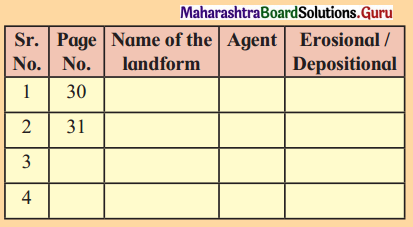
Answer:

Think about it. (Textbook Page No. 30)
Have you ever been to a river and seen its bed? Discuss in the class about your observation about the river, its banks, its bed and its velocity.
Answer:
[Students will discuss their experiences with teachers.]
![]()
Find out! (Textbook Page No. 31)
Find out famous examples of gorges and canyons.
Answer:
Following are the famous examples of gorges and canyons of the world.
- Fish River Canyon, Namibia
- Grand Canyon, Arizona, USA
- Tiger Leaping Gorge, China
- Kali Gandaki Gorge, Nepal
- Blyden River Canyon, South Africa
- Gorges du Verdon, France
- Indus Gorge, Pakistan
- Antelope Canyon, USA
1. Study figure given below and answer the following questions. (Textbook Page No. 38)

Question 1.
Which rocks are mainly found here?
Answer:
Soluble rock like limestone, a sedimentary rock composed of Calcium Carbonate (CaCO3) are found.
Question 2.
Identify the spot where stream disappears.
Answer:
Steam will disappear below the sink hole.
Question 3.
Which major erosional process works in this area?
Answer:
Solution is the major erosional process in this area.
Question 4.
Identify the landforms formed by deposition.
Answer:
Stalactite, Stalagmite, columns or pillars are the landforms formed by deposition.
Question 5.
Why do depositional landforms not form on the surface in areas of Karst terrain?
Answer:
In Karst terrain groundwater dissolves minerals like calcium carbonate present in the rocks. The dripping water leaves behind a deposit of calcium carbonate. The water saturated with calcium carbonate dripping on the floor of a cave deposits calcium carbonate on the floor. Thus, depositional landforms do not form on the surface in the areas of Karst terrain.
![]()
2. See the figure give below A, B, C. Answer the following questions. (Textbook Page No. 40)
Img 8
Question 1.
What difference do you find in the three figures?
Answer:
Fig A shows the regions before glacier formed.
Fig B showed the regions covered by snow during glaciation.
Fig C shows different erosional and depositional features formed by glaciers after glaciation period.
Question 2.
Identify the landforms formed due to erosion by glaciers.
Answer:
Cirques, horn, U-shaped valleys, hanging valleys are formed due to erosion by glaciers.
Question 3.
Where can U-Shaped valleys be formed?
Answer:
U- Shaped valley is formed in the pre-existing valley.
Question 4.
In which region will deposition occur?
Answer:
Deposition starts generally along the side and front of ice.
Question 5.
Identify the landforms formed by deposition by glaciers.
Answer:
Drumlins, eskers, moraines are the depositional features formed by glaciers.
Use your brain power! (Textbook Page No. 41)
In which diagram of the three will you find end moraines? See fig. 3.5 A, B, C.
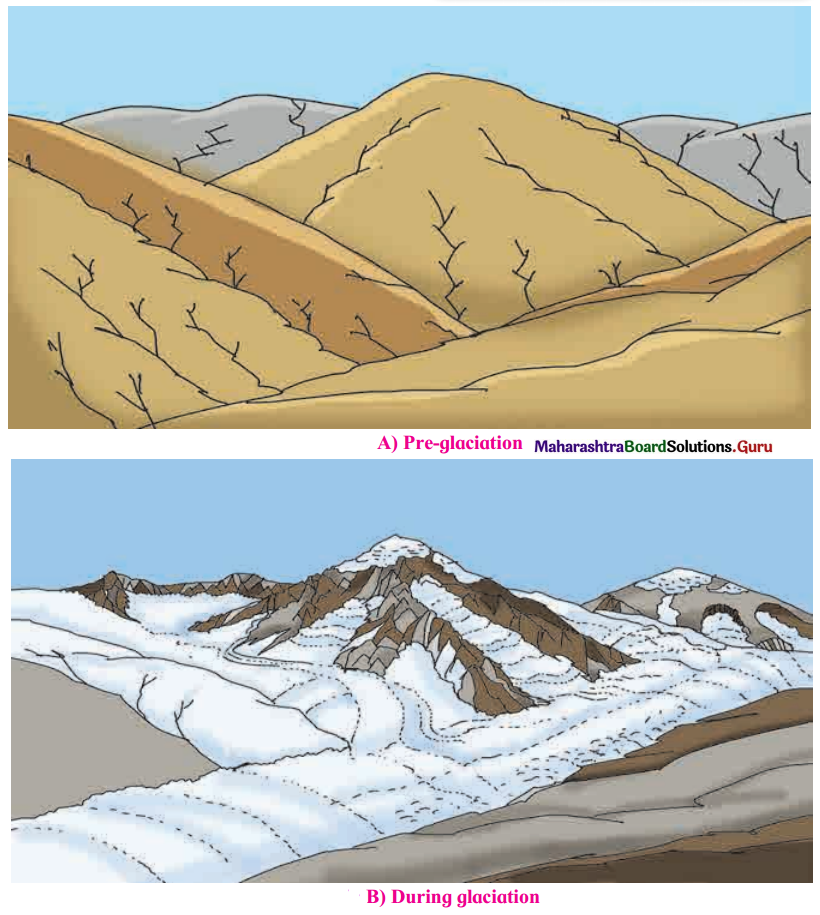
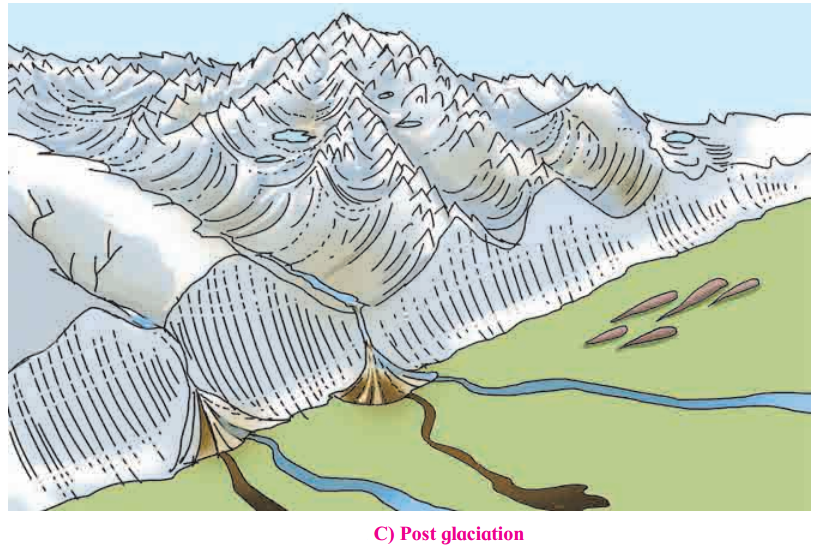
Answer:
We will find end moraines in Fig. C